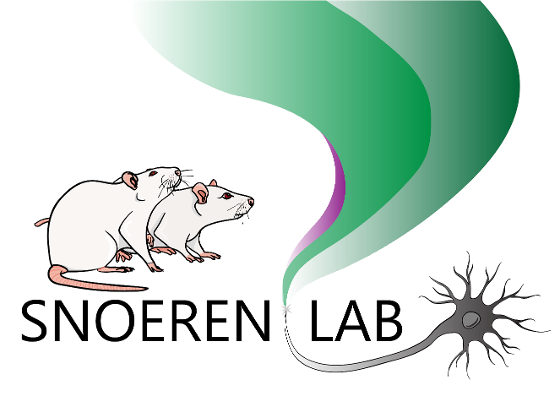Snoerenlab projects
In our research, we are interested in the understand the neurobiological basis of behavior, both in physiological and pathological circumstances. Our main interest lies in the behaviors that activate the brain reward system and respond to it. The reward system is a collection of brain structures and neural pathways that are highly involved in feelings of pleasure, reward and motivation. Different types of stimuli have attractive and motivational values (reward) that induce appetitive (approach) and consummatory behavior. Food and sexual partners are examples of ‘natural rewards’ or ‘primary rewards’, because they induce behaviors that are necessary to facilitate the survival of one’s self and offspring. At the same time, they are examples of ‘intrinsic rewards’, rewards that have an unconditioned, inherently pleasurable value.
Using a combination of traditional behavioral testing, modern manipulation methods, and advanced imaging, our research group is currently working on three different research lines:
1. The neurobiology of sexual motivation and behavior
2. The risks of excessive junk food consumption on the brain reward system
3. Antidepressant use during pregnancy: the neurodevelopmental effects on the offspring
The neurobiology of sexual motivation and behavior
Funded by the Norwegian research council FRIPRO-young talent grant (2015)
Rats are often used to study the mechanisms underlying sexual behavior, because of the large overlap in neuronal systems with humans. Sexual behavior in both humans and rats can mainly be divided into three phases: the introductory, copulatory, and the ejaculatory phase. The sexual drive during the introductory phase and the transition to the copulatory phase is the most important indicator for sexual motivation. It is, therefore, essential to include all these phases in research on sexual behavior as a natural reward. Interestingly, different brain areas become activated during different sexual phases, suggesting that different mechanisms are involved in the different parts of sexual behavior. This suggests that in order to complete the full cycle of sexual behavior from sexual motivation, copulation and ejaculation, certain brain areas should switch from an active state into an inactive state, or the other way around.
So far, old fashioned lesion or pharmacological studies may reveal the structures and projections needed for a behavior, but it has been proven difficult to unravel the precise connections or nature of these projections that are involved (lesions tend to affect both the direct and indirect pathways). In our research, we use the relatively new state-of-the-art technique of chemogenetics to circumvent most of these problems. Chemogenetics is a method that uses genetics to express chemically engineered (DREADD) receptors in neurons that can be turned on/off by the injection of exogenous molecules specific for these receptors (CNO). The injection of an AAV-virus, containing a DREADD/reporter fusion protein plasmid, in a brain area, will induce the expression of the DREADD receptors in all (or a neuron type-specific subset of) neurons originating in this area. Activation of the receptors by injection of CNO causes stimulation or inhibition of the neurons containing these receptors, while the other neurons without the receptors remain unaffected. The infusion of CNO in a projection area will, therefore, only activate/inhibit neurons originating from the virus-infected brain area. The indirect pathways do not contain DREADD receptors and are not affected. Thus, the functional properties of a specific projection can be investigated by chemogenetics, and will thereby generate more insights into the role of the communication between brain areas in sexual motivation and behavior.
The principle and usefulness of a similar technique (optogenetics) was explained in our blog:
http://blogg.uit.no/helsefak/shining-a-light-on-brain-function/
The risks of excessive junk food consumption on the brain reward system
Funded by Helse Nord (2018) and MSCA-IF (2020)
The prevalence of obesity worldwide continues to increase dramatically: 39% of adults are now overweight or obese. Excessive consumption of highly palatable sugar and fat laden foods, often referred to as “junk foods”, plays a central role in the development of obesity, possibly by dysregulating the brain reward system. In this project, we aim to investigate the neurological mechanisms by which excessive junk food consumption adversely affects the reward system. We hypothesize that desensitisation of the total reward system will cause overconsumption of all sorts of rewards. The novelty of this project is that it addresses this question by not only investigating the effects of junk food consumption on the alterations in sensitivity to conditioned food rewards, but by also studying the neural circuitry regulating responses beyond food rewards, e.g. secondary intrinsic (sexual) or extrinsic (monetary) rewards. This will be achieved with the unique approach of combining human and animal translational research, and by using a special behavioural design and advanced techniques that allows us to investigate all three phases of reward: i) expectation, ii) motivation/approach and iii) consummatory behaviour. The outcome of this study will contribute to explain the underlying mechanisms of the development of obesity and mental disorders associated with obesity. This will open up new strategies for biomedical research and therapeutic applications, both for obesity and addiction.
Antidepressant use during pregnancy: the neurodevelopmental effects on the offspring
Funded by Helse Nord (2015)
Depression during pregnancy can have long-lasting negative cognitive and emotional consequences for newborn babies, resulting in an increased risk of emotional problems, depression, and delay in developments. Although this might underline the importance of treating antenatal depression with pharmacological therapy, these antidepressants (like SSRIs) could by itself seriously affect the newborn as well. SSRIs are known to cross the placenta and are evident in breast milk, which then raises the question about the developmental safety for the children. Several studies have already described that SSRI treatment during pregnancy could be involved in for example disturbed social-emotional development, increased internalizing and externalizing behaviors and increased risk for autism in the offspring.
Unfortunately, the underlying biological mechanisms causing these problems in children remain largely unclear, partly because it is difficult to discern between the effects caused by the SSRIs or triggered by the depression itself: mothers who take antidepressants are in fact depressed, while healthy women do not use SSRIs. In our research project, we seek to circumvent these limitations of human research by using a rat model. In rats, we can study the behavioral alterations in social-, anxiety-and depressive-like behaviors and molecular changes in the brain in offspring due to antenatal depression, antidepressant treatment, or the combination thereof.
In order to investigate the behavioral alterations, we use a seminatural environmental set-up in which rats live in groups for several days and can express all aspects of behavior. We also expose them to stressors in this environment, like the sound of a predator to simulate stressful life-events. There exists an important relationship between stressful life events and physical health. Repeated exposure to stressful situations might eventually lead to depressive-like symptoms, probably due to mechanistic changes in the brain. Our seminatural environmental approach allows us to study their vulnerability to stressors in a social context which is translational to the real life of children.

